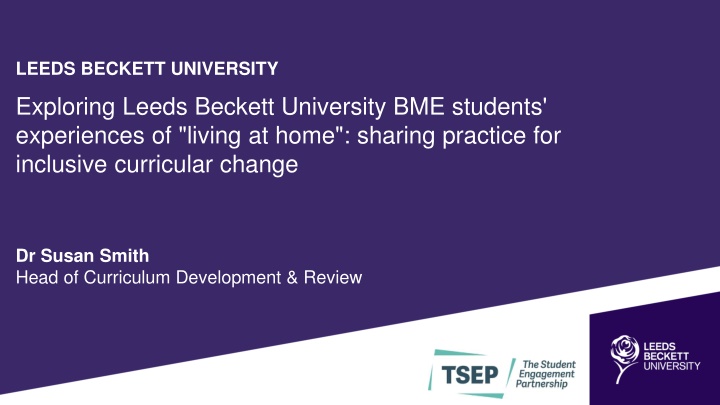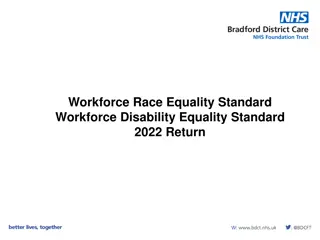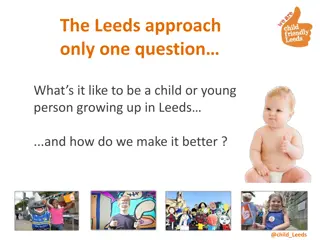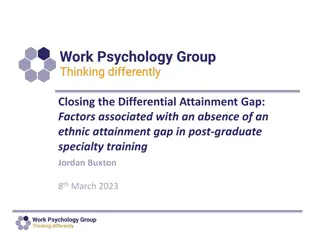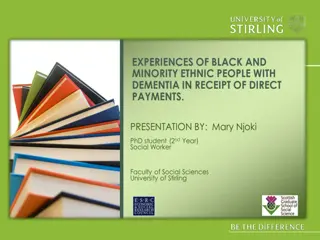Addressing the Attainment Gap Among BME Students at Leeds Beckett University
Literature reveals a significant attainment gap between BME and White students at Leeds Beckett University, with teaching and learning experiences playing a crucial role. This study focuses on exploring and identifying factors affecting BME student achievement, using a mixed methods approach to analyze attainment data, course documentation, and student narratives. Emergent issues related to assessment methods, placement strategies, and belonging are revealed, aiming to inform inclusive curricular changes for improved student outcomes.
Download Presentation

Please find below an Image/Link to download the presentation.
The content on the website is provided AS IS for your information and personal use only. It may not be sold, licensed, or shared on other websites without obtaining consent from the author.If you encounter any issues during the download, it is possible that the publisher has removed the file from their server.
You are allowed to download the files provided on this website for personal or commercial use, subject to the condition that they are used lawfully. All files are the property of their respective owners.
The content on the website is provided AS IS for your information and personal use only. It may not be sold, licensed, or shared on other websites without obtaining consent from the author.
E N D
Presentation Transcript
LEEDS BECKETT UNIVERSITY Exploring Leeds Beckett University BME students' experiences of "living at home": sharing practice for inclusive curricular change Dr Susan Smith Head of Curriculum Development & Review
Our Attainment Gap 2014-15 BME students vs White students Good Hons comparisons 2014-15 100.00% 90.00% 80.00% 75.72% 70.16% 69.41% 67.77% 67.30% 70.00% 60.00% 53.98% 53.33% 51.89% 51.39% 48.15% % BME Good Hons 50.00% 40.00% % White Good Hons 30.00% 20.00% 10.00% 0.00% Leeds Beckett University Faculty of Arts, Environment & Technology Carnegie Faculty Faculty of Business & Law Faculty of Health & Social Sciences
Literature indicates that the degree attainment gap is strongly related to the experience of teaching and learning at a university (Stephenson, 2012; Office for Fair Access [OFFA], 2015.) Commuting students needs can be inadvertently overlooked. Issues faced by BME commuting students are identical to those faced by all commuting students. However, BME students are already coping with a less adequate student learning experience and reduced attainment
Approach Review and critique of the literature identifying factors which impact on BME student achievement Mixed methods approach Audit and analysis of our attainment/access/achievement activity data, Race Equality Action Plan and Race Charter Mark data Analysis of achievement data and identification of 5 selected courses- (resit rates, living at home, retention rates, placement rates) Course document analysis Generation of evidence informed interview schedule Interview course leaders and key others The narrative of the students from student focus groups Action Plan
Emergent issues from review of course documentation Lack of clarity about assessment approaches, inclusive assessment formative assessment, group work specifics, Reading lists and resource lists Lack of explicit placement strategy- access, opportunity and diversity Lack of clarity over sense of belonging , expectations for all at first year, Induction as transition etc.
Emergent issues from thematic analysis of interviews - (students) Inclusive assessment- formative assessment I needed to do more practising for my assessments I was the first to go to Uni from my family and I didn t know what sort of level they wanted with my early assessments (Female, First year) Why is my curriculum white? There were so few black writers on my reading list (Female, Third year) The critical mass and the student voice I was the only Asian student in my group and didn t really feel I could speak up (Female, Third year) Anonymous marking Some scripts are marked online with just a student number attached. I know not everything can be anonymously marked but more could be. . (Male, Third year)
Emergent issues from thematic analysis of interviews - (students) Placement opportunities for BME students My Asian friends and I thought we would just go and work straight in the family business- there were jobs for us there (Male, 3rd year) Feeling of marginalisation and lack of confidence- induction I felt a bit left out at the beginning- the initial Freshers' week helped (Female, first year) Collaborative learning issues We tended to arrive together in the same car and stuck together in the same group as we sat together (Female 2nd year) Help seeking behaviours I only showed my personal tutor my draft essay at the last minute. It felt wrong to show her earlier- I felt a bit of a failure showing her something weak so I left it too late (Male, 2nd year)
Emergent issues from thematic analysis of interviews - (staff) Inclusive curricula - overly white curricula - let s interrogate our curricula . dehumanises those left out . Unconscious bias awareness The important role of induction as transition to learning @Level 4 The proportion of BME students on the course and their voice Opportunity to share values in a safe learning space foster critical thinking to allow issues to be explored Facilitate integration, learning and social opportunities via the teaching and learning approach- collaborative learning Assessment: inclusive, formative, scaffolded Anonymous marking
Living at home rates The living at home rates of BME undergraduate students were analysed In 2014-15, the living at home rates of the BME students were striking. Across our 5 courses an average of 53.4% compared to 18% 18% of their non BME student peers and this pattern remains unchanged in 2015-16. Above the national average for all undergraduate living-at- home students. 53.4% of our BME students lived at home
But what about the commuting students? Positives From the focus group... Home grown, pre established social and family network- active, positive choice to stay at home. Time management /compartmentalisation skills. The negotiation skills of all the students No homesickness Finances Travel time can be used productively
Issues Practicalities of travel Timetabling gaps - needing to make the most of being on campus Arriving together and leaving together Difficulties being on-campus for group projects and learning Reduced sense of belonging and the impact on retention The nature of participation The role of the family
Are these issues familiar to you? Are these issues familiar to you?
What have we done? No separate policies and practices but SU/University consultation necessary. More BME student representatives required. Induction Retention Independent and collaborative learning Enhancement of the students sense of belonging Panopto (opt out only)
Induction Clarity of expectations and attendance at course level Need to ensure all students build on the different forms of social and cultural capital universities can provide Expectations around group work and participation Expectations around all your own work and academic integrity Using online fora Encourage residentials /trips
Timetabling Social learning spaces Piloting CMIS Go Look at the gaps - so students don t go home ( first years), have gaps (final years). Early evening and lunchtime activities- more cross -course invitations Student wellbeing lunchtime sessions are popular Explore personalised timetables
Retention Wellbeing website Skype appointments with disability team Skills for Learning Site licence for assistive software accessible off campus Money advice team - telephone advice line Hardship fund - consider where student travelling from
Independent and collaborative learning Active group work management by the staff Physical movement in large lecture theatres Using students own experiences- authentic assessment Digital interactive gaming input in large lecture theatres Paired /interactive exercises/sharing of values in the classroom Active mixed allocation of groups especially in Level 4
Building a sense of belonging Learn names Personal tutoring/academic advising- available remotely Inclusive curricula - multicultural case studies, diverse reading lists, assessments varied Carefully timetabled course celebrations/activities
Especially for commuters Lunchtime activities Student society for commuters - buddy up and share transport Local students network - events (Sheffield) Consultation about policies/interventions through the reps Awareness of Equality Impact Assessments
What do you do already? What would you like to do?
Abrahams, J. and Ingram, N. (2013) The Chameleon Habitus: Exploring Local Students Negotiations of Multiple Fields in Sociological Review Online 18:4. Archer, L. and Hutchings, M. (2000) Bettering Yourself? Discourses of risk, cost and benefit in ethnically diverse, young working-class nonparticipants constructions of higher education in British Journal of Sociology of Education, 21:4, 555-574. Baik, C., Naylor, R. and Arkoudis S. (2015) The first year experience in Australian universities: findings from two decades, 1994-2014, Melbourne Centre for the Study of Higher Education, The University of Melbourne. Clegg, S., Stevenson, J., and Willott, J. (2009) Staff conceptions of curricular and extracurricular activities in higher education. Journal of Higher Education. Published online August 2009. DOI 10.1007/s10734-009-9269-y.
Dante, A., Fabris, S. and Palese, A. (2013) Time-to event analysis of individual variables associated with nursing students academic failure: a longitudinal study. Advances in Health Sciences Education, 18: 1047-1065. Department for Business, Innovation and Skills (2014) Learning from Futuretrack: studying and living at home (London: BIS). http://www.hecsu.ac.uk/assets/assets/documents/Futuretrack_BIS_Learning_from_futuretrack_st udying_and_living_at_home.pdf (Accessed 11 January 2017). Guardian (2013) Why I live at home and commute to University https://www.theguardian.com/education/mortarboard/2013/jan/16/live-at-home-and-commute-to- university The Guardian (Accessed January 11 2017). Guardian (2014) Rise of the live-at-home student commuter. https://www.theguardian.com/education/2014/aug/26/rise-live-at-home-student-commuter. The Guardian (Accessed 11 January 2017). Helsen, E. (2013) The role of Student Services and Support in attaining commuter students, London: AMOSSHE. http://www.amosshe.org.uk/resources/Documents/AMOSSHEis20- Kingston-The-role-of-Student-Services-and-support-in-attaining-commuter-students.pdf. (Accessed 11 January 2017).
Higher Education Academy and National Union of Students (2011) Student Engagement Toolkit [Internet]. Higher Education Academy and National Union of Students. Available from: https://www.nusconnect.org.uk/campaigns/highereducation/student- engagement/toolkit/resources/ (Accessed 21 December 2016). Higher Education Statistics Agency (2015) Term-time accommodation of all full-time students. Higher Education Statistics Agency. https://www.hesa.ac.uk/content/view/3312 Loke, G. and Berry, J. (2011) Improving the Degree attainment of Black and Minority Ethnic students. Report. Equality Challenge Unit and Higher Education Academy http://www.ecu.ac.uk/wp-content/uploads/external/improving-degree-attainment-bme.pdf Newbold, P., Mehta, S. and Forbes, J. (2011) A study of non-traditional and traditional students in terms of their time management behaviors, stress factors, and coping strategies, Academy of Educational Leadership Journal, 15. National Union of Students (2015) Policy and Practice for students living in the parental home. National Union of Students.https://nusdigital.s3-eu-west- 1.amazonaws.com/document/documents/15933/50ae6b302ef91f5639b8f0ef0dd7d4f8/Reaching %20Home.pdf?AWSAccessKeyId=AKIAJKEA56ZWKFU6MHNQ&Expires=1482235410&Signatu re=mpi%2FxJDFYobrZIAm292Y5XryErU%3D
Office for Fair Access (2015) OFFA Topic Briefing: BME Students - OFFA [Online]. Retrieved from: https://www.offa.org.uk/universities-and-colleges/guidance-and-useful-information/topic- briefings/offa-topic-briefing-bme-students/ (Accessed 9 May 2016). Pickford, R. (2016) Student Engagement: Body, Mind and Heart A Proposal for an Embedded Multi-Dimensional Student Engagement Framework, Journal of Perspectives in Applied Academic Practice, Vol 4, No 2. Richardson, J. (2008a). Degree attainment, ethnicity and gender: A literature review. York. https://www.heacademy.ac.uk/searchn/site/assets%20York%20documents%20ourwork%20rese arch%20J%20Richardson%20literature%20review%20Jan08%20pdf Richardson, J. T. E. (2008b). The attainment of ethnic minority students in UK higher education. Studies in Higher Education, 33(1), 33-48. Sage, J., Evandrou, M. and Falkingham, J. (2013) Onwards or Homewards? Complex Graduate Migration Pathways, Well-being, and the Parental Safety Net in Population, Place and Space 19:6, 738-755. Stevenson, J. (2012). Black and Minority Ethnic Student Degree Retention and Attainment [Online]. Retrieved from: https://www.heacademy.ac.uk/sites/default/files/bme_summit_final_report.pdf Thomas, L. (2002) Student retention in higher education: the role of institutional habitus , Journal of Education Policy, 17:4, 423-442. Thomas, L. (2012) Building student engagement and belonging in Higher Education at a time of change: final report from the What Works? Student Retention & Success programme (London: Paul Hamlyn Foundation).
